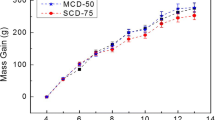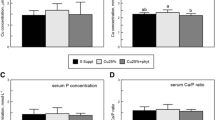Abstract
Bone cell activity and the composition of the femur of laying hens were studied during 7 days of calcium depletion on a 0.13% calcium diet and 7 days of calcium repletion on a 3.2% calcium diet. Histologically, only cortical bone showed clear signs of bone resorption and osteoclastic activity during the depletion period. The number of osteoclasts in medullary bone varied little from control values throughout both calcium depletion and repletion, except for a significant increase on the first day of depletion. The major histologicalchange in medullary bone was a marked increase in the number of osteoblasts on the third, fifth and, to a lesser extent, seventh, day of depletion. The number of osteoblasts in medullary bone was positively correlated with its osteoid content and negatively correlated with its degree of calcification. Alkaline phosphatase activity of medullary bone increased with the time the hens had been on the calcium-deficient diet. Returning the hens to the 3.2% calcium ration caused, within one day, a significant increase in medullary bone calcification, a decrease of osteoblast numbers to, or below, control levels, and a drastic reduction in alkaline phosphatase activity of medullary bone. The significance of these findings in relation to the control of bone cell populations and the functions of medullary bone is discussed.
Résumé
L'activité des cellules osseuses et la composition du fémur de pondeuses furent examinées pendant sept jours de déficience calcique (diète contenant 0,13% de calcium) et sept jours de réplétion (diète contenant 3,2% de calcium). Du point de vue histologique, seul l'os cortical donnait des signes nets de résorption et d'activité ostéoclastique. Le nombre d'ostéoclastes dans l'os médullaire différait peu des valuers témoin pendant les périodes de déficience et de réplétion subséquente, sauf pour une augmentation significative au premier jour de déplétion. L'effect histologique le plus important dans l'os médullaire était une augmentation marquée en nombre d'ostéoblastes aux troisième, cinquième, et un peu moins au septième jours de déplétion. Le nombre d'ostéoblastes était en corrélation positive avec la teneur de l'os médullaire en ostéoide et négative avec son degré de calcification. L'activité de l'os médullaire en phosphatase alcaline augmentait avec la longueur de la déficience calcique. Un jour après le retour des pondeuses à une diète contenant 3,2% de calcium, la calcification de l'os médullaire avait augmenté de façon significative, le nombre d'ostéoblastes avait diminué au niveau ou au-dessous du niveau de contrôle et l'activité de la phosphatase alcaline avait baissé considérablement. L'importance de ces résultats est discutée par rapport au controle des populations des cellules dan l'os et au rôle de l'os médullaire.
Zusammenfassung
Die Zahl der Knochenzellen und die Zusammensetzung des Femurs von Legehennen wurden während einer siebentägigen Calciumentzugsperiode (Calciumgehalt des Futters 0,13%) und einer siebentägigen Ersatzperiode (Calciumgehalt des Futters 3,2%) untersucht. Histologisch zeigte nur die Cortex eindeutige Knochenresorption und osteoklastische Aktivität. Abgesehen von einer signifikanten Zunahme am 1. Tag des Calciumentzuges, variierte die Zahl der Osteoklasten im Markknochen sowohl während der Entzugs- als auch während der nachfolgenden Ersatzperiode wenig. Die wichtigste histologische Änderung im Markknochen bestand in einer starken Zunahme in der Zahl der Osteoblasten am 3., 5. und etwas weniger am 7. Tag der Entzugsperiode. Die Zahl der Osteoblasten zeigte eine positive Korrelation mit dem Osteoidgehalt des Markknochens und eine negative mit dem Grade seiner Verkalkung. Die Aktivität der alkalischen Phosphatase im Markknochen war desto größer je länger den Hennen die calciumarme Ration verfüttert worden war. Die Wiederverabreichung der Ration, welche 3,2% Calcium enthielt, verursachte innerhalb eines Tages eine signifikante Zunahme in der Verkalkung des Markknochens, ein Absinken der Osteoblastzahl auf die Kontrollwerte oder unter sie und eine drastische Verringerung der alkalischen Phosphataseaktivität. Die Bedeutung dieser Ergebnisse in bezug auf die Kontrolle des Knochenzellenbestandes und auf die Funktion des Markknochens wird diskutiert.
Similar content being viewed by others
References
Benoit, J., Clavert, J.: Action ostéogénétique directe et locale de la folliculine démonstrée chez le Canard et le Pigeon, par son introduction localisée dans un os long. C. R. Soc. Biol. (Paris)139, 728–730 (1945).
Bloom, M. A., Domm, L. V., Nalbandov, A. V., Bloom, W.: Medullary bone of laying chickens. Amer. J. Anat.102, 411–453 (1958).
Bloom, W., Bloom, M. A., McLean, F. C.: Calcification and ossification. Medullary bone changes in the reproductive cycle of female pigeons. Anat. Rec.81, 443–475 (1941).
Comar, C. L., Driggers, J. C.: Secretion of radioative calcium in the hen's egg. Science109, 282 (1949).
Common, R. H.: Observations on the mineral metabolism of pullets. J. Agric. Sci.28, 347–366 (1938).
Deobald, H. J., Lease, E. J., Hart, E. B., Halpin, J. G.: Studies on the calcium metabolism of laying hens. Poultry Sci.15, 179–185 (1936).
Hurwitz, S., Griminger, P.: The response of plasma alkaline phosphatase, parathyroids and blood and bone minerals to calcium intake in the fowl. J. Nutr.73, 177–184 (1961).
Lowry, O. H., Roberts, N. R., Mei-Ling Wu, Hixon, W. S., Crawford, E. J.: The quantitative histochemistry of brain. II. Enzyme measurements. J. biol. Chem.207, 19–37 (1954).
Motzok, I.: Studies on the plasma phosphatase of normal and rachitic chicks. 2. Relationship between plasma phosphatase and the phosphatases of bone, kidney, liver and intestinal mucosa. Biochem. J.47, 193–196 (1950).
Mueller, W. J., Schraer, R. Schraer, H.: Calcium metabolism and skeletal dynamics of laying pullets. J. Nutr.84, 20–26 (1964).
Sadek, F. S., Reilley, C. N.: A survey of the application of visual indicators for the chelometric alcium determination in serum. J. Lab. Clin. Med.54, 621–629 (1959).
Simkiss, K.: Calcium in reproductive physiology. New York: Reinhold Publ. Corp. 1967.
Taylor, T. G., More, J. H.: Skeletal depletion in hens laying on a low calcium diet. Brit. J. Nutr.8, 112–124 (1954).
Urist, M. R.: The effects of calcium deprivation upon the blood, adrenal cortex, ovary and skeleton in domestic fowl. Recent Prog. Hormone Res.15, 455–477 (1959).
Yuile, C. L., Chen, P. S., Bosmann, B.: Antirachitic sterols in chicks. Rachitic bone lesions in chicks after multiple graded doses of vitamin D and dihydrotachysterols. Arch. Path.83, 241–250 (1967).
Author information
Authors and Affiliations
Additional information
Authorized as paper no. 3510 in the Journal Series of the Pennsylvania Agricultural Experiment Station. This investigation was supported in part by U. S. Public Health Service Research Grant AM-04362 from the National Institutes of Health.
Rights and permissions
About this article
Cite this article
Zallone, A.Z., Mueller, W.J. Medullary bone of laying hens during calcium depletion and repletion. Calc. Tis Res. 4, 136–146 (1969). https://doi.org/10.1007/BF02279115
Received:
Accepted:
Issue Date:
DOI: https://doi.org/10.1007/BF02279115




